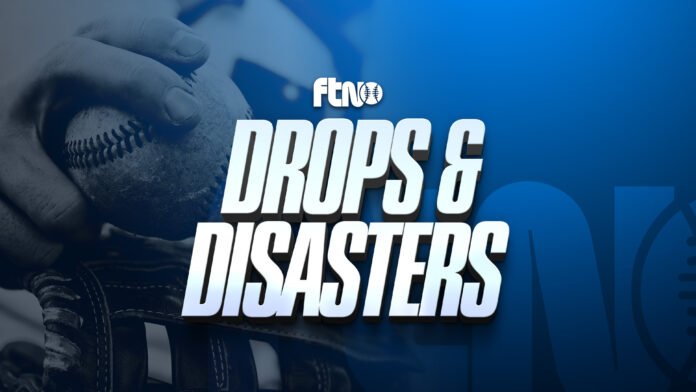While this article tends to be NFBC-centric, focused on season-long roto leagues, those leagues increasingly reward managers who play a weekly game. While there are benefits associated with remaining patient with slumping players, such patience needs to be tempered with a sense of urgency. After all, very competitive leagues are frequently won – and lost – by the slimmest of margins. All experienced roto managers have tales of winning or losing leagues based on one or just a few runs, wins, strikeouts, etc. Thus, there are strong incentives to try to maximize weekly stats as much as possible, which requires some churning of roster spots and targeting favorable matchups.
Here is a recent example. Toronto has been playing well and Nathan Lukes worked his way into a strong-side platoon role, even playing occasionally versus left-handed starters. Against right-handed starters, Lukes has been leading off, with players such as Bo Bichette and Vladimir Guerrero Jr. hitting right behind him. Notwithstanding strong playing time and solid performance, Lukes was widely available in 12- and 15-team leagues (in fact, Lukes is currently rostered in only three-quarters of Main Event leagues and barely one-tenth of Online Championship leagues). This past week, the Blue Jays traveled to Colorado for a three-game series against the Rockies at Coors Field – a fantastic streaming opportunity. As you now know, the Blue Jays obliterated the Rockies, outscoring them 45-6 in the series. Lukes went 6-for-13 (.462) with one home run, six runs scored and six RBIs. Should managers have dropped star outfielders to stream someone like Lukes for a week or half a week? No, but I would wager that most teams are rostering a sixth or seventh outfielder, or an extra player at another position, that could have been safely dropped for Lukes in advance of last week’s matchup.
As the regular (and fantasy) season winds down, it makes less sense to be patient with struggling players or ones who are experiencing reduced playing time. There simply is less runway available for such players to experience a turnaround and for the manager to benefit from it (and that’s assuming that a turnaround will definitely occur, which in reality is no sure thing). To be clear, there are potential drawbacks to streaming players (and I am far more prone to stream hitters than pitchers). First, for every player a manager picks up to stream, a player has to be dropped, and there are no guarantees that player can be rostered again (assuming that is even desirable). Second, streamed players may not perform well over a limited sample, even with a favorable matchup. Third, some potential streams are more popular or obvious than others, and FAAB will need to be spent to implement more frequent transactions (although bids normally should be tempered for players targeted for just one or a few series).
For managers who missed streaming Lukes and/or other Blue Jays hitters this past week, fear not – similar opportunities are available virtually every week. Looking ahead to this week, the Diamondbacks visit Coors Field on Thursday to start a four-game series against the Rockies. The Dodgers travel to Colorado the following week for four games. Since July 1, Washington pitchers have an ERA well over 6.00, and the Phillies play seven games against the Nationals over the next two weeks. The Rays and the Angels travel to hitter-friendly Sacramento for series this week, while Phillies and Brewers hitters each get to enjoy three games at Great American Ball Park in Cincinnati.
If looking to stream pitchers, virtually anyone facing the Rockies away from Coors Field is worthy of consideration (the Rockies, last in MLB for runs scored on the road, have scored exactly half of the runs of the Brewers, who rank first in that category). Similarly, the Pirates have the second-fewest runs scored and the lowest number of home runs on the road in MLB. The Royals have scored the fewest runs and hit the fewest home runs at home in all of MLB. In other words, viable streaming opportunities exist on both the hitting and the pitching sides virtually every week (although the streaming options at starting pitcher in 15-team leagues are often not for the faint of heart). Managers should assess these opportunities and consider whether retaining marginal players who may not even be starters for them represents an optimal strategy, or if more aggressive streaming should be implemented.
Some of the players who should at least be considered as potential drops this week are set forth below in the following two tables – the first includes hitters and the second includes pitchers. In addition to the player’s name, team and position, the tables include the player’s ownership percentage in the premier 15- and 12-team contests: the NFBC’s Main Event and Online Championship, respectively. Finally, the tables list my rankings as to how strongly – or not – I feel each particular player should be dropped in those 15-team and 12-team formats, respectively. The key to these rankings, from 0-4, is as follows:
- 0 = Do not drop
- 1 = Team context dependent; probably should not be dropped on most teams
- 2 = Team context dependent; compelling arguments to drop and not drop
- 3 = Team context dependent; probably should be dropped on most teams
- 4 = Drop
